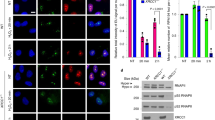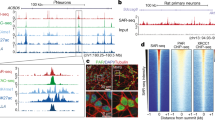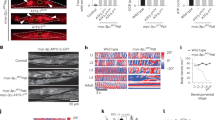Abstract
DNA replication and repair in mammalian cells involves three distinct DNA ligases: ligase I (Lig1), ligase III (Lig3) and ligase IV (Lig4)1. Lig3 is considered a key ligase during base excision repair because its stability depends upon its nuclear binding partner Xrcc1, a critical factor for this DNA repair pathway2,3. Lig3 is also present in the mitochondria, where its role in mitochondrial DNA (mtDNA) maintenance is independent of Xrcc1 (ref. 4). However, the biological role of Lig3 is unclear as inactivation of murine Lig3 results in early embryonic lethality5. Here we report that Lig3 is essential for mtDNA integrity but dispensable for nuclear DNA repair. Inactivation of Lig3 in the mouse nervous system resulted in mtDNA loss leading to profound mitochondrial dysfunction, disruption of cellular homeostasis and incapacitating ataxia. Similarly, inactivation of Lig3 in cardiac muscle resulted in mitochondrial dysfunction and defective heart-pump function leading to heart failure. However, Lig3 inactivation did not result in nuclear DNA repair deficiency, indicating essential DNA repair functions of Xrcc1 can occur in the absence of Lig3. Instead, we found that Lig1 was critical for DNA repair, but acted in a cooperative manner with Lig3. Additionally, Lig3 deficiency did not recapitulate the hallmark features of neural Xrcc1 inactivation such as DNA damage-induced cerebellar interneuron loss6, further underscoring functional separation of these DNA repair factors. Therefore, our data reveal that the critical biological role of Lig3 is to maintain mtDNA integrity and not Xrcc1-dependent DNA repair.
This is a preview of subscription content, access via your institution
Access options
Subscribe to this journal
Receive 51 print issues and online access
$199.00 per year
only $3.90 per issue
Buy this article
- Purchase on Springer Link
- Instant access to full article PDF
Prices may be subject to local taxes which are calculated during checkout




Similar content being viewed by others
References
Ellenberger, T. & Tomkinson, A. E. Eukaryotic DNA ligases: structural and functional insights. Annu. Rev. Biochem. 77, 313–338 (2008)
Caldecott, K. W., McKeown, C. K., Tucker, J. D., Ljungquist, S. & Thompson, L. H. An interaction between the mammalian DNA repair protein XRCC1 and DNA ligase III. Mol. Cell. Biol. 14, 68–76 (1994)
Ljungquist, S., Kenne, K., Olsson, L. & Sandstrom, M. Altered DNA ligase III activity in the CHO EM9 mutant. Mutat. Res. 314, 177–186 (1994)
Lakshmipathy, U. & Campbell, C. Mitochondrial DNA ligase III function is independent of Xrcc1. Nucleic Acids Res. 28, 3880–3886 (2000)
Puebla-Osorio, N., Lacey, D. B., Alt, F. W. & Zhu, C. Early embryonic lethality due to targeted inactivation of DNA ligase III. Mol. Cell. Biol. 26, 3935–3941 (2006)
Lee, Y. et al. The genesis of cerebellar interneurons and the prevention of neural DNA damage require XRCC1. Nature Neurosci. 12, 973–980 (2009)
Almeida, K. H. & Sobol, R. W. A unified view of base excision repair: lesion-dependent protein complexes regulated by post-translational modification. DNA Repair (Amst.) 6, 695–711 (2007)
Caldecott, K. W. Single-strand break repair and genetic disease. Nature Rev. Genet. 9, 619–631 (2008)
Wang, H. et al. DNA ligase III as a candidate component of backup pathways of nonhomologous end joining. Cancer Res. 65, 4020–4030 (2005)
Lakshmipathy, U. & Campbell, C. The human DNA ligase III gene encodes nuclear and mitochondrial proteins. Mol. Cell. Biol. 19, 3869–3876 (1999)
Lakshmipathy, U. & Campbell, C. Antisense-mediated decrease in DNA ligase III expression results in reduced mitochondrial DNA integrity. Nucleic Acids Res. 29, 668–676 (2001)
Pinz, K. G. & Bogenhagen, D. F. Efficient repair of abasic sites in DNA by mitochondrial enzymes. Mol. Cell. Biol. 18, 1257–1265 (1998)
Krishnan, K. J. et al. What causes mitochondrial DNA deletions in human cells? Nature Genet. 40, 275–279 (2008)
LeDoux, S. P. et al. Repair of mitochondrial DNA after various types of DNA damage in Chinese hamster ovary cells. Carcinogenesis 13, 1967–1973 (1992)
Liu, P. et al. Removal of oxidative DNA damage via FEN1-dependent long-patch base excision repair in human cell mitochondria. Mol. Cell. Biol. 28, 4975–4987 (2008)
Tomkinson, A. E., Bonk, R. T. & Linn, S. Mitochondrial endonuclease activities specific for apurinic/apyrimidinic sites in DNA from mouse cells. J. Biol. Chem. 263, 12532–12537 (1988)
Van Houten, B., Woshner, V. & Santos, J. H. Role of mitochondrial DNA in toxic responses to oxidative stress. DNA Repair (Amst.) 5, 145–152 (2006)
Tyynismaa, H. & Suomalainen, A. Mouse models of mitochondrial DNA defects and their relevance for human disease. EMBO Rep. 10, 137–143 (2009)
Wallace, D. C. & Fan, W. The pathophysiology of mitochondrial disease as modeled in the mouse. Genes Dev. 23, 1714–1736 (2009)
Trifunovic, A. et al. Premature ageing in mice expressing defective mitochondrial DNA polymerase. Nature 429, 417–423 (2004)
Wallace, D. C., Fan, W. & Procaccio, V. Mitochondrial energetics and therapeutics. Annu. Rev. Pathol. 5, 297–348 (2010)
DiMauro, S. & Schon, E. A. Mitochondrial disorders in the nervous system. Annu. Rev. Neurosci. 31, 91–123 (2008)
Chan, D. C. Mitochondrial dynamics in disease. N. Engl. J. Med. 356, 1707–1709 (2007)
Chan, S. S. & Copeland, W. C. DNA polymerase gamma and mitochondrial disease: understanding the consequence of POLG mutations. Biochim. Biophys. Acta 1787, 312–319 (2009)
Moser, J. et al. Sealing of chromosomal DNA nicks during nucleotide excision repair requires XRCC1 and DNA ligase IIIα in a cell-cycle-specific manner. Mol. Cell 27, 311–323 (2007)
Reynolds, J. J. et al. Defective DNA ligation during short-patch single-strand break repair in ataxia oculomotor apraxia 1. Mol. Cell. Biol. 29, 1354–1362 (2009)
Bentley, D. J. et al. DNA ligase I null mouse cells show normal DNA repair activity but altered DNA replication and reduced genome stability. J. Cell Sci. 115, 1551–1561 (2002)
Sleeth, K. M., Robson, R. L. & Dianov, G. L. Exchangeability of mammalian DNA ligases between base excision repair pathways. Biochemistry 43, 12924–12930 (2004)
Wang, J. et al. Dilated cardiomyopathy and atrioventricular conduction blocks induced by heart-specific inactivation of mitochondrial DNA gene expression. Nature Genet. 21, 133–137 (1999)
Nakai, A. et al. Developmental changes in mitochondrial activity and energy metabolism in fetal and neonatal rat brain. Brain Res. Dev. Brain Res. 121, 67–72 (2000)
Simsek, D. et al. Crucial role for DNA ligase III in mitochondria but not in Xrcc1-dependent repair. Nature 10.1038/nature09794 (this issue)
Acknowledgements
We thank the Hartwell Center for biotechnology support, the Transgenic Core Facility for blastocyst injections and the Animal Resources Center for animal husbandry. We also acknowledge the Light Microscopy Core, the Electron Microscopy Core and C. Calabrese and the Animal Imaging Core for magnetic resonance imaging and echocardiography analysis. P.J.M. is supported by the National Institutes of Health (NS-37956, CA-21765), a Cancer Center Support Grant (P30 CA21765) and the American Lebanese and Syrian Associated Charities of St Jude Children’s Research Hospital. S.K. is a Neoma Boadway AP Endowed Fellow.
Author information
Authors and Affiliations
Contributions
Y.G., S.K. and Y.L. performed all experiments characterizing the Lig3-deficient mouse and contributed to writing the manuscript. Y.G. and H.R.R. generated the targeted embryonic stem cells for blastocyst injection and were responsible for colony production and maintenance with assistance from S.K. and Y.L. S.K. and J.Z. established the functional analyses of ligases. J.E.R. provided pathology analysis. P.J.M. was project leader and produced the final version of the manuscript.
Corresponding author
Ethics declarations
Competing interests
The authors declare no competing financial interests.
Supplementary information
Supplementary Figures
The file contains Supplementary Figures 1-8 with legends. (PDF 9838 kb)
Supplementary Movie 1
This movie shows three Lig3Nes-cre mice at twelve days of age (P12) that have developed profound ataxia, compared with a wild-type littermate. (MOV 15516 kb)
Supplementary Movie 2
This movie shows loss of Lig3 affects mitochondrial function, using Mitotracker Red staining of astrocytes isolated from the Lig3Nes-cre brain by live-cell confocal imaging. While control astrocytes show a pattern of streaming mitochondria, the Lig3 mutant cells show altered mitochondrial dynamics with a static and pulsating appearance. (MOV 7322 kb)
Rights and permissions
About this article
Cite this article
Gao, Y., Katyal, S., Lee, Y. et al. DNA ligase III is critical for mtDNA integrity but not Xrcc1-mediated nuclear DNA repair. Nature 471, 240–244 (2011). https://doi.org/10.1038/nature09773
Received:
Accepted:
Published:
Issue Date:
DOI: https://doi.org/10.1038/nature09773
This article is cited by
-
Cancer predisposition genes in Japanese children with rhabdomyosarcoma
Journal of Human Genetics (2022)
-
Clinical implementation of RNA sequencing for Mendelian disease diagnostics
Genome Medicine (2022)
-
Mining massive genomic data of two Swiss Braunvieh cattle populations reveals six novel candidate variants that impair reproductive success
Genetics Selection Evolution (2021)
-
DNA repair deficiency in neuropathogenesis: when all roads lead to mitochondria
Translational Neurodegeneration (2019)
-
Structures of DNA-bound human ligase IV catalytic core reveal insights into substrate binding and catalysis
Nature Communications (2018)
Comments
By submitting a comment you agree to abide by our Terms and Community Guidelines. If you find something abusive or that does not comply with our terms or guidelines please flag it as inappropriate.



